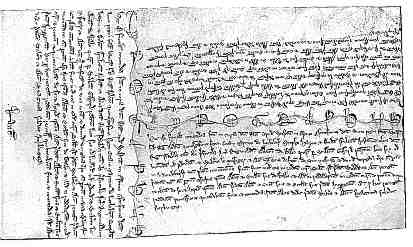


If you are looking at this page without frames, there is more information about medieval writing to be found by going to the home page (framed) or the site map (no frames).
| Chirographs, Indentures and Final Concords (2) | |
| The chirograph form was used to record legal agreements which had been arrived at through law court proceedings. This form of agreement is referred to as a final concord or fine. Under these circumstances, the chirograph could consist of three parts rather than two, one of which was retained by the court as a record. From the 13th century these third components were archived in the treasury and are referred to as feet of fines. They provide a record of civil actions in the courts for the later medieval period. | |
 |
|
| A complete trio of chirographs with the foot of 1272 (National Archives, Museum Case H, No.96). Below, a detail from the upper left corner of the lower chirograph. (From Johnson and Jenkinson 1915) | |
 |
|
| The above example is a rare instance where the two chirograph sheets and the foot have been able to be reassembled to show how the thing was constructed. Both the horizontal and vertical wavy cuts go through the word CYROGRAPHUM in elaborate decorative capitals. The lower detail shows how they fit together, and the standard formulae Hec est final concordia which begins the text. | |
| The legal action which resulted in the production of a final concord was generally essentially fictitious, and became a mechanism for getting around difficulties in the law, particularly with respect to transfer of property between private individuals. In other words, the plaintiff and defendant were essentially in collaboration. Changes to land ownership made such subterfuges unnecessary in the post-medieval period, so the example below appears to be an anachronism, dating as it does from the reign of Elizabeth I and essentially being a sale of property in Southwark. To complete the anachronistic mystery, the document is in Latin. | |
 |
|
| First few lines of a final concord of 1584 involving transfer of property in Southwark for 200 silver marks (British Library, add. charter 70729). By permission of the British Library. | |
| In fact, the fictitious lawsuit remained in use until 1833, and final concords were drawn up using the medieval formula, the Latin language, and a rather mannered version of the 15th century legal script from which the above example is derived, until that time. | |
| The practice of using a third copy of a chirograph for ratification was evidently known in the Anglo-Saxon era, but it became established as a procedure of the royal chancery at the end of the 12th century. Like other forms of written documentation, the chirograph or indenture worked its way down the social scale during the course of the middle ages. It had been used for international treaties and declarations of loyalty between magnates in the 12th century, but proliferated to become a very common legal instrument for transaction of all kinds at many levels of society. | |
|
|
|
|
|
|
|
If you are looking at this page without frames, there is more information about medieval writing to be found by going to the home page (framed) or the site map (no frames). |
|